Category: 116th
Idaho Army National Guard rescues injured hiker near Stanley
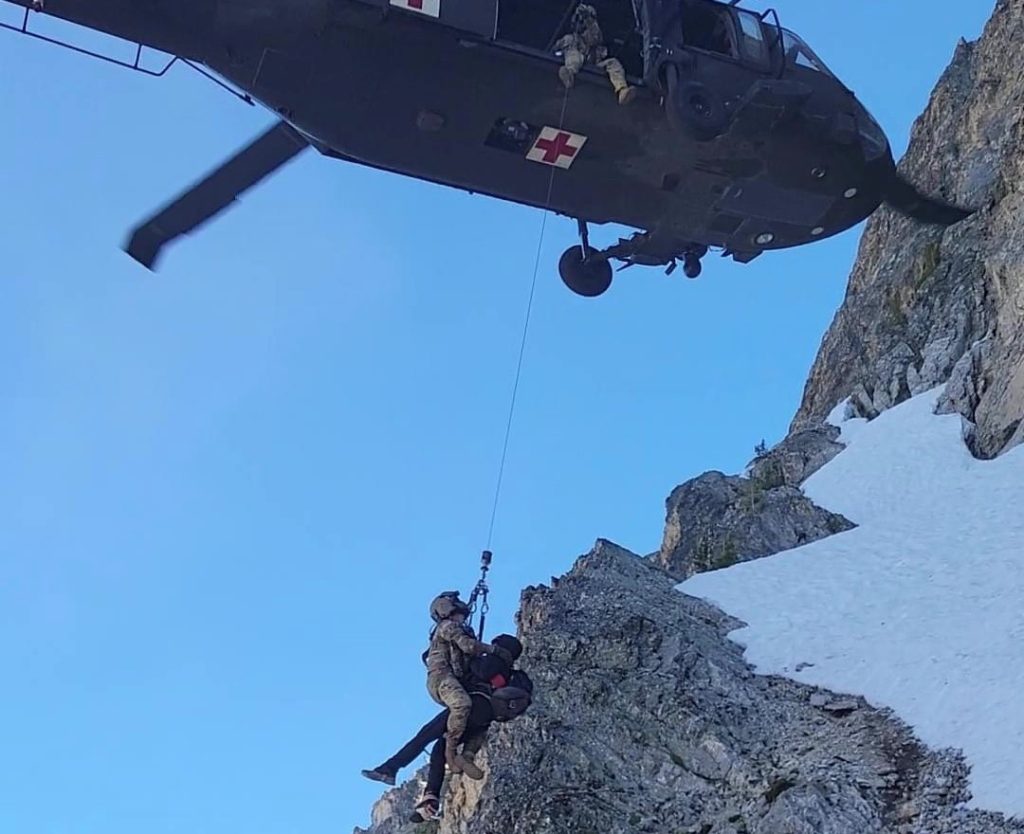
The Idaho Army National Guard’s State Aviation Group assisted Custer County Search and Rescue with the rescue of an injured hiker July 6 on Thompson Peak of the Sawtooth Range, outside of Stanley, Idaho.
The hiker, a 19-year-old male, suffered an ankle injury following a fall while rock-climbing near the mountain range’s highest peak, located approximately 75 miles outside of Boise.
“Our crew did an incredible job under some very challenging environmental conditions,” said Capt. Katherine Smith, commander of Det. 1, Company G 1st of the 168th Aviation Regiment. “The rescue required a great deal of crew coordination, as well as teamwork with the highly proficient extraction team from the Custer County Sheriff’s Office.”
The flight crew consisted of pilots Chief Warrant Officer 3 Theron Cameron and Chief Warrant Officer 3 Brennan Hoover; two crew chiefs, Sgt. Adam Brundy and hoist operator Sgt. Jessica Adamson; and one medic, Sgt. 1st Class Jared Gilstad.
The patient was initially located on a shear rock wall under a ledge. After locating him, crew members determined that there was no way to safely insert a hoist rider and extract him. The flight crew then flew to the Stanley Airport and picked up a five-person technical rope rescue team from Custer County’s search and rescue team.
“We were able to inert the team about 300 meters away from the patient using a two-wheel landing,” said Chief Warrant Officer 3 Theron Cameron, an Idaho Army National Guard UH-60 pilot.
The rescue team roped to the patient and relocated him to more favorable recovery site, where Adamson was able to lower Gilstad safely onto the ground near him. Gilstad quickly secured the patient and Adamson hoisted the pair back into the aircraft while the pilots kept the aircraft stable in challenging conditions.
“Due to the reduced power margins caused by altitude of more than 10,300 feet, the uneven terrain and the location of the extraction site, the aircrew was forced to pay extremely close attention to the aircraft limitations,” said Smith. “Lack of situational awareness in these types of situations could lead to a loss of lift or even rotor drop, requiring the aircrew to have to execute an emergency procedure to maintain stable flight.”
The flight crew transported the patient to the Stanley Airport, where he was transferred to civilian medical care.
Bolt assumes command of Alpha Company ‘Animals’
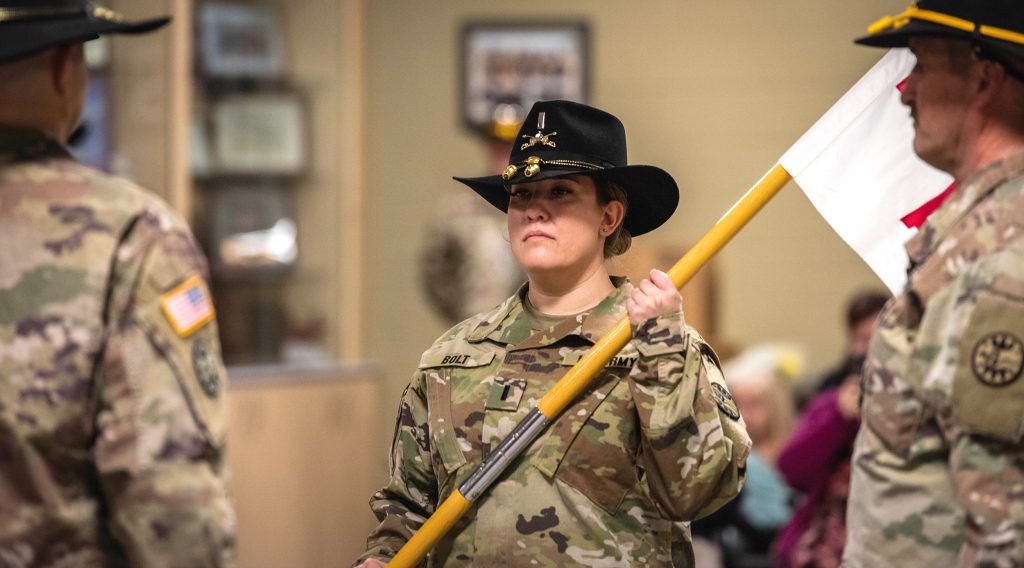
1st Lt. Lauren Bolt became the first female Idaho National Guard Soldier to command a line unit in the 116th Cavalry Brigade Combat Team when she took her post as the commanding officer of Company A, 2-116th Combined Arms Battalion during a Feb. 26 change of command ceremony at the unit’s headquarters in Emmett, Idaho. The 2-116th is headquartered in Caldwell with units in Emmett and Nampa.
“I’m excited to be joining Alpha Company as their new commander,” said Bolt. “For the rest of this year, we have a lot to accomplish. However, I have nothing but trust, faith and confidence in the team that Capt. Edwards and 1st Sgt. Taft Bearden have built.”
Bolt, who has since been promoted to captain, relieved Capt. Arthur Edwards, who has led the unit since August 2020. Bolt enlisted in the Nevada National Guard in 2015 and initially served as a motor transport operator. She was commissioned in May 2017 as an armor officer through the University of Nevada, Las Vegas ROTC program and began her career with the Idaho National Guard as a platoon leader for Company B, 2-116th CAB. In 2019, then 2nd Lt. Bolt made Idaho history when she and fellow 2nd Lt. Brooke Berard graduated from the U.S. Army’s Armor Basic Officer Leaders Course as the state’s first two female armor officers. She has since served as the executive officer of both Company B and Headquarters and Headquarters Company. In Bolt’s most recent post she served as the battalion’s maintenance officer during its deployment in support of Operation Spartan Shield.
“I am confident in her ability to continue the Animal Company’s legacy of mission success.,” said Lt. Col. Barrett Bishop, 2-116th CAB commanding officer. “I was the battalion executive officer when Lauren was a new platoon leader, and she has developed herself well in Army competence and personal tact.”
The Army opened combat arms jobs to female Soldiers in 2015. Over the past decade, Idaho National Guardsmen have transitioned into career fields not previously open to them or reached new heights in their fields while continuing to ensure the organization remains “Always Ready, Always There” to respond to emergencies at home and abroad.
In 2014, Maj. Kimberly Tschepen became the state’s first female Soldier to command a battalion when she took command of the 145th Brigade Support Battalion and Command Sgt. Maj. Linda Burkhart became the state’s first female command sergeant major in 2015.
In 2015, Idaho Guardsman 1st Sgt. Erin Smith became the first female enlisted Soldier in the nation to graduate from M1 Armor Crewman School. Following her, Staff Sgt. Kylene Huerta completed the same course and became the first female Soldier to be assigned to the 116th CBCT as a tank crew member.
In 2017, Sgt. 1st Class Melanie Galletti graduated from the U.S. Army’s Infantryman Course as the Idaho National Guard’s first qualified female enlisted infantry Soldier. That same year, Col. Lora Rainey was appointed as the state’s first female staff judge advocate.
In 2019, 2nd Lt. Jessica Pauley became the state’s first female infantry officer.
Edwards’ departing remarks focused on reminding Company A Soldiers of their accomplishments and the pride he felt as their commander over the past two years.
“From day one, I have been beyond impressed with the professionalism and dedication of Alpha Company Soldiers,” said Edwards. “We have supported local and national callings, all while being part of an all-volunteer force … and I could not be prouder of serving alongside those volunteers.”
Total Force: Army, Air, Navy train together in mass casualty combat exercise
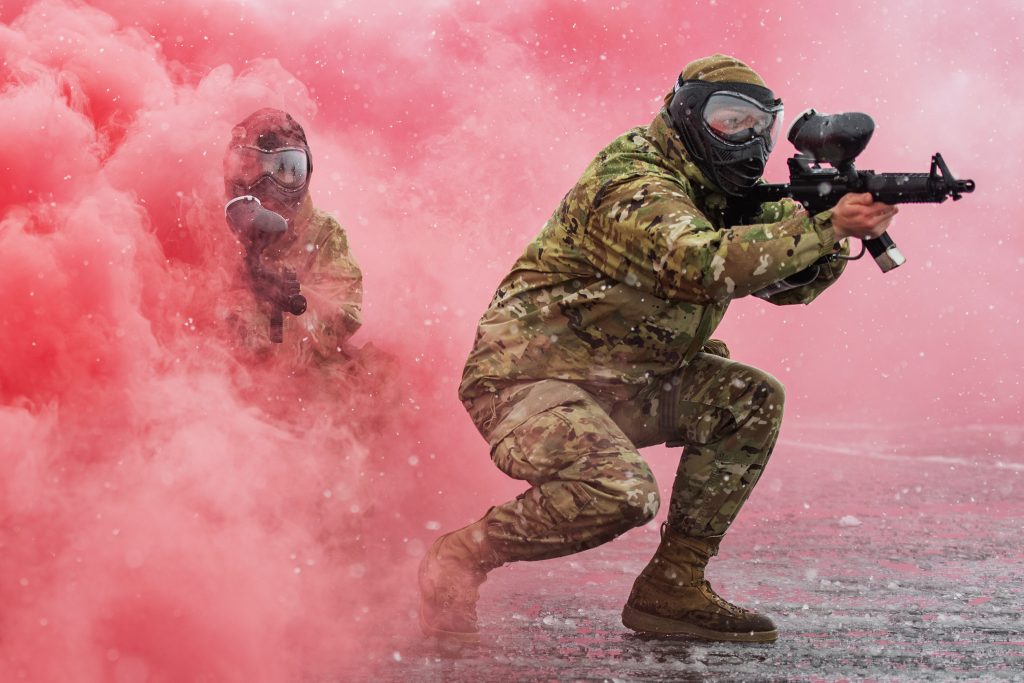
Master Sgt. Becky Vanshur/Idaho Military Division Public Affairs
BOISE, Idaho – A deep breath in, deep breath out. An Airman from the Idaho Air National Guard holds his weapon steady in front of him, pressing it against his shoulder, finger on the trigger, his body low to the ground. He takes a small, strategic step into the plume of smoke swirling around him. Surrounded by a blanket of red smoke makes it hard to see his battle buddy but he knows his counterpart, a Soldier from the Idaho Army National Guard’s Medical Detachment, is close behind him.
The red smoke is used to conceal the medical team’s movements as they defend their medical structures and personnel who are being ambushed while conducting Tactical Combat Casualty Care on the battlefield. The two Guardsmen were among approximately 200 Idaho National Guard Soldiers, Airmen and their active duty and Navy Reserve counterparts who joined forces for a mass casualty combat exercise, Feb. 1-4, near Gowen Field.
“The main focus of this joint services training was to all come together, learn each other’s jobs and create multi-capable Soldiers, Airmen and Sailors on top of learning how to respond in mass casualty scenarios,” said Senior Master Sgt. Davis Nguyen, the 124th Medical Group function area manager. “Equally important, was the ability to perform medical care while under mental and physical stress.”
The Idaho Air National Guard’s Critical Care Air Transport Team, the ground surgical team and other medical personnel from the 124th Medical Group conducted the exercise with the Idaho Army National Guard’s Charlie Company, 145th Brigade Support Battalion Medical Detachment and medevac Soldiers from the 1st of the 168th Aviation Regiment; the Navy Operational Support Center; and active duty Airmen with the 366th Medical Group from Mountain Home Air Force Base.
During the exercise, Soldiers, Airmen and Sailors learned each other’s roles on the battlefield and in the sky. The Idaho Army National Guard’s State Aviation Group incorporated UH-60 Black Hawk helicopters and pilots who responded to 9-Line medevac requests, transporting critical care patients with CCATT officers and medevac Soldiers who stabilized them onboard while flying through simulated combat zones until they reached a higher echelon of care.
“All of our pilots need to practice this piece of the exercise and learn how to fly with patients in the back,” said Chief Warrant Officer 3 Theron Cameron, instructor pilot and medical evacuation officer from the 168th Aviation Regiment. “We need to learn the CCATT’s language to know if they are in the middle of performing a procedure as it cues us to fly as smoothly as possible through the combat areas, while communicating back that we may need to aggressively maneuver around danger.”
Airmen from the 124th Fighter Wing’s Security Forces provided combat lessons on defense and protection, 360-degree security, care under fire and tactical movements with red smoke concealment.
Colin Yates, an Idaho Peace Officers Standards and Training instructor specializing in wounds and trauma for tactical medicine, created realistic wounds on 124th Fighter Wing’s Student Flight role players acting as casualties for a more real-world training experience of TCCC on the battlefield.
Sailors from the NOSC provided the medical logistics support for the simulated deployment location, while learning from both Army and Air medics on tactical field care, casualty evacuation and Roles 1-4 medical care facilities.
“It’s anticipated in future conflicts, there will be a lot more integration with forces. We need to interact with each other and speak each other’s languages,” said Maj. Mark Urban, CCATT physician. “This exercise was developed with that in mind, being able to integrate is really key to that Total Force concept.”
One team, one fight: Army and Air join forces for mass casualty, medevac training
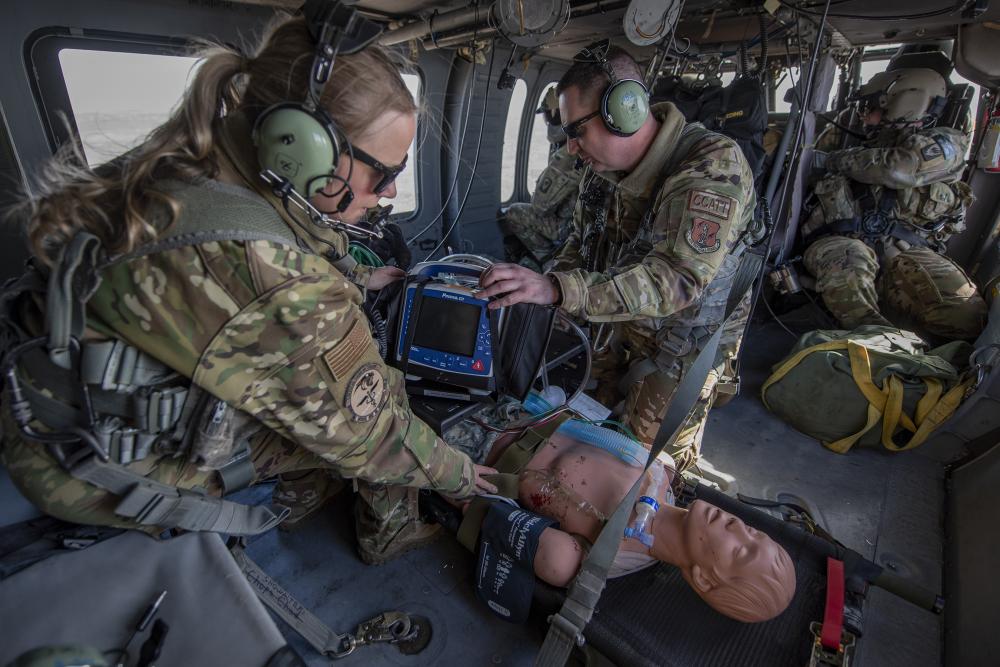
Idaho National Guard Soldiers and Airmen, as well as active duty counterparts joined forces with a one-team, one-fight mentality for joint training during a mass casualty exercise on Feb. 4 near Gowen Field.
“The best way to grow our mindset of becoming more operational and ready for a deployed environment is to train with the nearby resources, such as the Idaho Army National Guard and our active duty counterparts,” said Senior Master Sgt. Virginia Holmgren, a respiratory therapist from the Idaho Air National Guard’s 124th Medical Group. “Forming relationships with the other branches helps us to become familiar with each other’s capabilities and to practice working together because when we are in a deployed environment we will be working with the other branches in the fight.”
Medical personnel from Gowen Field’s 124th Medical Group and active duty medical personnel with the 366th Medical Group from Mountain Home Air Force Base teamed up for several mass casualty events, which also included the use of medevac Soldiers and UH-60 Black Hawk helicopters from the Idaho Army National Guard’s 1st of the 168th Aviation Regiment to participate in the medical evacuation scenarios.
“This exercise is a great example of how the Idaho National Guard is committed to the joint warfighting doctrine in support of the National Defense Strategy,” said Brig. Gen. Tim Donnellan, Idaho Air National Guard commander. “The 124th Medical Group coordinated this incredible training using combat proven units from the Idaho Army National Guard, the Idaho Air National Guard, and the Gunfighters of the 366th Fighter Wing.”
During the scenarios, combat medics performed treatment and stabilized casualties at a field medical tent in a simulated deployed location. The focus for the combat medics during the mass casualty scenarios was an emphasis on Tactical Combat Casualty Care. The TCCC is the military guideline for trauma life support in pre-hospital combat medicine, designed to reduce preventable deaths while continuing to maintain operation success.
“With our new DoD guidelines for the TCCC, it requires us to have more hands-on deck and for more Airmen to be familiar with trauma care in responding to worse injuries out on the field rather than the typical self aid and buddy care that we have focused on in the past,” said Senior Master Sgt. Davis Nguyen, the 124th Medical Group Function Area Manager.
Once medics respond and stabilize casualties, they could then recognize the patients that needed more advanced critical care at a hospital outside of the combat field location and the 9-Line medevac call requesting the Black Hawk medevac team was made. In combat, the 9-Line is an emergency medevac request with an accurate report of combat injuries that is often the difference between life and death.
The ground combat medics and the Black Hawk flight medics worked together to stabilize the casualty during flight until they reached the simulated higher echelon of medical care.
Additional scenarios required protective gear to be worn during a chemical, biological, radiological or nuclear event while Idaho National Guard Soldiers conducted hoist rescue training, allowing Airmen the chance to gain insight into a full range of rescue capabilities of the medevac Soldiers.
“I am proud of the commitment of the men and women in this joint, total force exercise demonstrating the incredible talent and the first class training capabilities we have here in Idaho,” said Donnellan. “We will continue to maintain our readiness for the immediate fight while preparing for any conflicts of the future.”
Idaho Soldiers return home from overseas deployment
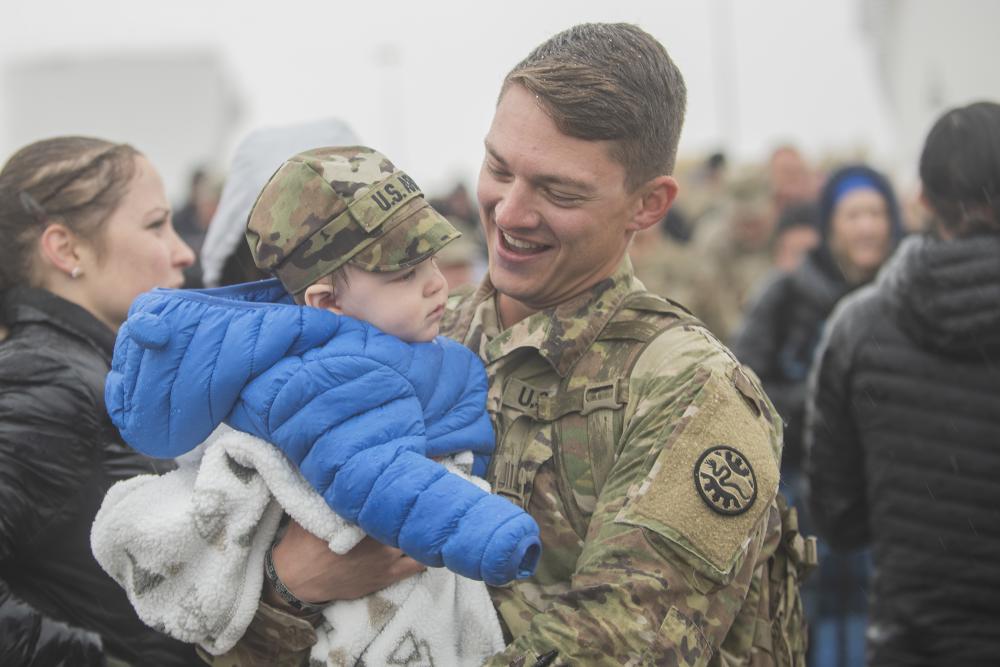
The Idaho Army National Guard welcomed home to Boise, Idaho, nearly 100 116th Cavalry Brigade Combat Team Soldiers on Nov. 4th after a yearlong deployment to Southwest Asia in support of Operation Spartan Shield. An additional 100 other Soldiers returned to their communities elsewhere across the state throughout the day.
“These Soldiers embody what the National Guard is all about: citizen-Soldiers who serve their nation when called upon and return home to their families and communities,” said Brig. Gen. Farin Schwartz, commander, Idaho Army National Guard. “It’s an honor to welcome these Soldiers home and I thank each one of them for their service and dedication to our state and nation. For 10 months, our Soldiers deterred enemy aggression in a very hostile environment, symbolizing our nation’s commitment to our global partners and allies.”
The Soldiers deployed in November 2021 to support the 116th Cavalry Brigade Combat Team’s Task Force Griz, which was headquartered by the Montana Army National Guard and included Soldiers from the Idaho, Montana, Florida and Nevada Army National Guards.
Idaho Soldiers comprised nearly 20 percent of the task force, which spent 10 months overseas, in addition to receiving 45 days of training stateside before deploying.
OSS is a joint mission under the United States Central Command and is part of Operation Enduring Freedom. The task force provided three mission response forces to the CENTCOM commander and conducted missions and training exercises in Iraq, Jordan, the Kingdom of Saudi Arabia, Kuwait, Syria and Qatar.
The task force conducted security and stability operations and demonstrated the U.S.’s continued commitment to deterring adversaries while supporting regional allies. The task force was relieved in October by another 116th CBCT-led task force, including more than 600 Idaho Soldiers, who are expected to return next year.
Task Force Griz Soldiers began returning to Fort Bliss, Texas, Oct. 24 and conducted demobilization activities before returning home.
The 116th CBCT previously deployed in support of the Global War on Terror in 2004 and 2010 to Iraq.
Idaho National Guard develops fiscal wellness through finance counseling

Crystal Farris/Idaho Military Division Public Affairs
Capt. Ashley Thropp, who serves as a behavioral health officer for the Idaho Army National Guard and a clinical social worker for the U.S. Department of Veterans Affairs, always knew how to earn money, budget and save.
She joined the military when she was 17, always lived below her means and ate bean and cheese burritos while earning her undergraduate degree because they were cheap and easy.
Although she still lives below her means now, it was only after having her son two years ago, that Thropp realized she didn’t understand the first thing about investing.
At that time, Thropp decided to meet with one of the Idaho National Guard’s financial counselors to learn ways to invest her money, set herself up for a better retirement and plan for her son’s future.
“I just had my son and was working from home at the time,” said Thropp. “My unit had put out information about free financial counseling and I wondered if the counselors could answer some questions about how my family could make better financial choices for our future.”
Financial counseling services
The Idaho National Guard’s financial counselors help with tax assistance, offer support and counseling opportunities for credit management and provide training in money management, budgeting and home buying. They also help service members in reaching long term goals, such as emergency savings, education, buying a house and retirement.
“Just like we need to see a medical professional for our annual check-ups, it’s a good idea to see a financial professional to ensure a financial fit future,” said Jennifer Wood, a personal finance counselor with the Idaho National Guard.
Statistically, Wood said financial issues are reported in the top three areas where service members struggle the most. Since a service member’s financial problems affect their military readiness, the Idaho National Guard provides free financial counseling and services through Accredited Financial Counselors, like Wood, who are available to all branches of the military, their family members, Gold Star families and veterans within 180 days of transitioning out of the military.
Initial financial appointments take approximately an hour and can be conducted in person, over the phone or by video conference. During that time, a financial counselor will get to know a person’s financial situation, gather information and develop a plan forward.
“Together we identify where they are and where they want to be financially in the future,” said Wood. “Setting future financial goals gives the client somewhere to allocate money. The goals are identified, labeled and achieved by monthly allocations.”
Making a return on her investment
During Thropp’s visit with the financial counselor, she said they discussed the five basic TSP funds, the Lifecycle funds and how Thropp felt about investment risk.
“The financial counselor talked me through each of the different TSP funds, how they work and about risk tolerance,” said Thropp. “I learned how choosing a different fund could mean I take more risk with my investment, but the gain is significantly better. She also helped me come up with some investment percentages that I was comfortable with and that made sense to me.”
After her meeting with the financial counselor, Thropp chose to move her TSP funds from the G fund to more aggressive C and S options. Thropp said she is pleased that her retirement investment grew after only several months.
The Thrift Savings Plan is the federal government’s sponsored retirement plan for employees, which all military service members are eligible for. Although she has been contributing 15 percent of her Guard earnings since 2005, Thropp never accessed or managed her money in the TSP and was therefore defaulted to the G option, which Wood describes as a glorified savings account.
“I didn’t understand risk tolerance and investing before meeting with the financial counselor,” said Thropp. “I didn’t understand the G fund only grew by very small percentages, compared to the C and S funds, which move with the market and have already grown significantly since I made the switch. I just wish I would have known about the benefits of contributing to different funds earlier.”
In addition to TSP investment opportunities, Thropp learned the importance of other investments, standalone mutual funds and investing in her children’s education through a 529 Education Account. The 529 account is an education investment account, offered in every state, that within Idaho also offers a state tax advantage.
Wood said the money in a 529 accrues much of the same way the TSP does, except it can only be used toward all qualified education expenses, including K-12 schooling and expenses such as tuition, books and school supplies.
“I learned that the 529 plan moves with the market and grows more over the years than it would through a savings account,” said Thropp. “The financial counselor showed me a graph of how the market has grown over the last hundred-year period. I opened mine last year, contributing $50 a paycheck in the market investment. So far, I’ve invested $1,750 of my own money and it’s already at $2,600.”
While different TSP options and a 529 were the best fit for Thropp, financial counselors are able to provide information and options to service members and their families based on individual needs.
All investments have risk, Wood said, and the amount of risk one is willing to take is the amount of return an investor should expect to see.
“Not everyone is in a position for a high-risk, high-reward investment,” said Wood. “That is why I recommend investing in mutual funds vs. stock instruments for beginning investors. I realize block chain currency, like Bitcoin, is a flashy and exciting way to invest, but it is also risky. I’ve seen service members who live paycheck to paycheck invest in cryptocurrency hoping to make a windfall return, only to lose money in the end. Investing slow and steady is the best way to gain wealth.”
For Thropp, she said her goal was to contribute as much as possible now toward her retirement, while she is still young and able to afford taking higher risks with her investments.
Grateful for Guard benefits
“In past years, I think I may have taken for granted the services and benefits we are offered as Guardsmen, like the free financial counseling,” said Thropp. “I can easily call or set up a video chat with a financial counselor. Other people don’t have that and when I look at it from that perspective, I realize how amazing it is to have these benefits at my fingertips and I try to share that knowledge with others.”
Thropp said she encourages other Guardsmen to invest in their TSPs and meet with a financial counselor about their retirement and investment opportunities to help prepare them for their futures.
“I pass that information on because I wish I would have known it myself early on,” said Thropp. “The Guard has so many opportunities and benefits available to us, if we only take advantage of it. I’m very grateful for the Guard and what it has provided me over the years to grow and improve my life both personally and professionally.”
Beside financial services, the Idaho National Guard’s Service Member and Family Support program also offers referral resources for crisis intervention, legal resources, TRICARE resources, emergency family assistance, community information and outreach and financial services.
Visit https://www.imd.idaho.gov/personal-finance-counseling/ and https://www.imd.idaho.gov/idaho-national-guard/family-programs/ for more information.
Idaho Army National Guard Soldiers prepare for deployment
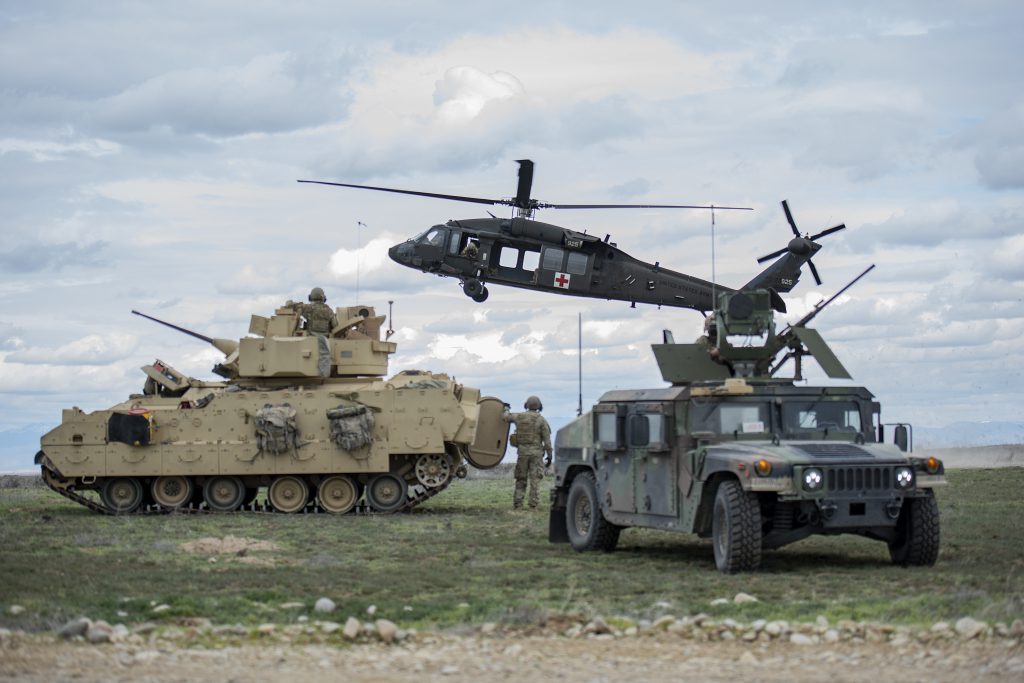
Maj. Robert Taylor/Idaho Military Division Public Affairs
The 2nd of the 116th Combined Arms Battalion conducted an extended drill period March 24 – April 1 at the Orchard Combat Training Center to build team proficiency prior to deploying in support of Operation Spartan Shield later this year.
“The battalion did a phenomenal job coming together as a team,” said Maj. Sam McDowell, 2-116th CAB commander.
M1A2 Abrams and M2A3 Bradley Fighting Vehicle crews conducted Table VI crew qualification tables and will build off their crew-level proficiencies to conduct platoon qualifications at annual training in May prior to mobilization and conducting a combined arms live-fire exercise at Fort Bliss, Texas.
The unit took advantage of several of the OCTC’s 23 training ranges to conduct individual weapon qualifications, crew-served weapon qualifications, a staff exercise, sniper training, Javelin firing and mortar training to Table III.
The battalion also teamed up with the Idaho Army National Guard’s 1st of the 183rd Assault Helicopter Battalion to conduct medevac and combat search and rescue training as well as air insertion missions on a simulated village located within the OCTC.
More than 700 116th Cavalry Brigade Combat Team Soldiers, comprising a task force led by the 2-116th CAB, will deploy to Southwest Asia for approximately 12 months in support of OSS later this year. OSS is a joint mission under the United States Central Command and is part of Operation Enduring Freedom.
The task force will relieve Task Force Griz, which is currently performing the same mission. Task Force Griz is led by the 116th CBCT’s 1st of the 163rd CAB and consists of Soldiers from the Idaho, Montana, Nevada and Oregon National Guards as well as augmentees from the Florida National Guard. More than 20 percent of the current task force is made up of Idaho Army National Guard Soldiers.
“The Soldiers of the 116th CBCT are training hard and will be prepared for this mission when they deploy,” said Lt. Col. Eric Orcutt, 116th CBCT commander.
The 116th Cavalry Brigade Combat Team previously deployed in support of the Global War on Terror in 2004 and 2010 to Iraq. Idaho National Guard personnel have been supporting the state of Idaho throughout the COVID-19 pandemic since 2020 and assisted the Idaho Department of Lands battle wildfires across the state last summer. Additionally, more than 400 Idaho Air National Guardsmen deployed to Southwest Asia in the summer of 2020.
Leveling up: Female Soldiers, Airmen serve in leadership positions across the Idaho National Guard
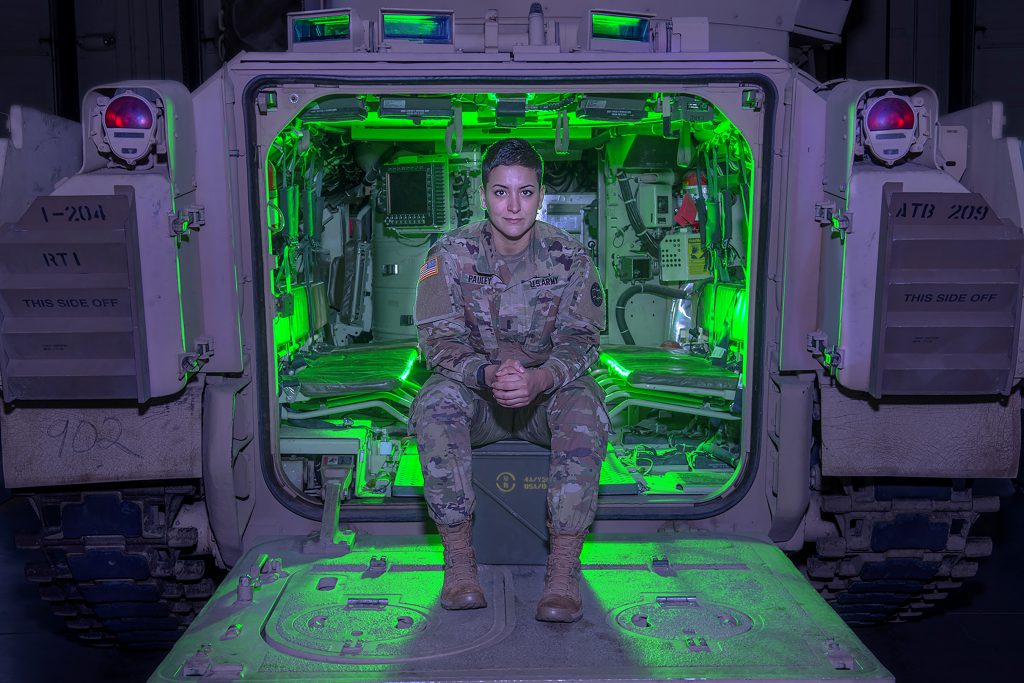
Maj. Robert Taylor/Idaho Military Division Public Affairs
Betty Corn became the first female to serve in the Idaho Air National Guard when she joined as a nurse in 1959. Female members wouldn’t enlist into the National Guard until 1968.
Since then, female citizen-Soldiers and Airmen have continued to blaze their own paths in the Idaho National Guard, even before the Army integrated females into combat-arms in 2015. Over the past decade alone, Idaho National Guardsmen have transitioned into career fields that were not previously opened to them or reached new heights in their profession while continuing to ensure the organization remains “Always Ready, Always There” to respond to emergencies at home or in defense of our national interest throughout the world.
In 2012, then Cpt. Nicole Smith, now Lt. Col. Nicole Washington, led more than a 100 Company A, 1-168th General Support Aviation Battalion Soldiers to Afghanistan for a year-long deployment, becoming the first female officer to lead an Idaho National Guard unit to combat as its senior officer.
In 2013, Chief Master Sgt. Tammy S. Ladley became the first female to serve as the 124th Fighter Wing’s senior enlisted member. The next year, Col. Sherrie McCandless became the first female to command the wing. McCandless now serves as the commanding general of the D.C. National Guard.
Also in 2014, Maj. Kimberly Tschepen became the state’s first female Soldier to command a battalion when she took command of the 145th Brigade Support Battalion and Command Sgt. Maj. Linda Burkhart became the state’s first female command sergeant major in 2015.
In 2015, Idaho Guardsman 1st Sgt. Erin Smith became the nation’s first female enlisted Soldier to graduate from M1 Armor Crewman School. Following her, Staff Sgt. Kylene Huerta completed the same course and became the first female Soldier to be assigned to the 116th Cavalry Brigade Combat Team as a tank crew member. In 2017, Sgt. 1st Class Melanie Galletti graduated from the U.S. Army’s Infantryman Course as the Idaho National Guard’s first qualified female enlisted infantry Soldier.
In 2017, Col. Lora Rainey was appointed as the state’s first female staff judge advocate.
In 2019, 2nd Lt. Brooke Berard and 2nd Lt. Lauren Bolt graduated from the U.S. Army’s Armor Basic Officer Leaders Course as the state’s first two female armor officers and 2nd Lt. Jessica Pauley became the state’s first female infantry officer.
Today, female Soldiers and Airmen proudly serve in leadership positions at every level of the Idaho National Guard, from the team level in the Army Guard to the group level in the Air Guard. In honor of women’s history month, we celebrate not only their accomplishments, but the fact that many of them are still writing their own history within our organization.
Female Soldiers and Airmen are trusted to lead their fellow Guardsmen. Soldiers like Sgt. Kaylee Bloxham, a combat engineer in charge of a Bradley Fighting Vehicle and its crew; and Airman like Chef Master Sgt. Kelly Bongiovi, who now serves as the senior enlisted member of the Idaho Air National Guard after she replaced Ladley as the 124th Fighter Wing’s command chief master sergeant.
On the officer side, 2nd Lt. Jessica Pauley, will lead an infantry platoon of infantry on a deployment later this year and Col. Elizabeth Sumner, the highest-ranking female in the Idaho National Guard, leads more than 340 Airmen as the 124th Mission Support Group commander.
Sgt. Kaylee Bloxham
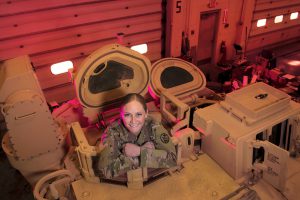 Sgt. Kaylee Bloxham didn’t set out to be the Idaho Army National Guard’s first female 12B combat engineer. It’s a feat she didn’t realize she had accomplished until after she graduated from the required reclassification course.
Sgt. Kaylee Bloxham didn’t set out to be the Idaho Army National Guard’s first female 12B combat engineer. It’s a feat she didn’t realize she had accomplished until after she graduated from the required reclassification course.
She was only looking to serve her country and follow in her older sister’s footsteps when she enlisted into the Idaho Army National Guard in 2006 as a military police Soldier. She reclassed after the 116th Brigade Special Troops Battalion transitioned to the 116th Brigade Engineer Battalion in 2016 and the unit eliminated its MP platoon.
Bloxham chose to become a combat engineer after observing engineers train on C4 demolition during annual training. However, she’s been assigned to a Bradley Fighting Vehicle for the past six years and has yet to complete demolition training herself since reclassing.
“I didn’t like the Bradley at first,” she said. “I didn’t know how it functioned, but now that I’ve been on it for a while and know how it functions, I really like it.”
Bloxham is a vehicle commander in A Company, 116th Brigade Engineer Battalion.
“Not only am I responsible for myself, I’m responsible for two others,” she said.
As a vehicle commander, she is also responsible for a 30-ton armored vehicle equipped with three weapon systems and its gunner and driver. She’s responsible for helping the driver maintain situational awareness in a vehicle with large blind spots and identifying and confirming enemy targets before giving the gunner the command of execution to fire.
“It’s fun,” she said.
She said she loves being able to lead and train her crew as a part-time member of the Idaho National Guard. When she’s not training, she also works as a parts specialist for High Desert Bobcat in Twin Falls.
Staff Sgt. Antonia Lemos
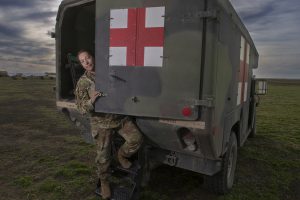 Staff Sgt. Antonia Lemos always knew she wanted to work in the medical profession when she was a kid. She never became a doctor because she didn’t finish college, but by enlisting into the Idaho Army National Guard, she was able to become a 68W combat medic and still have a career in the medical profession.
Staff Sgt. Antonia Lemos always knew she wanted to work in the medical profession when she was a kid. She never became a doctor because she didn’t finish college, but by enlisting into the Idaho Army National Guard, she was able to become a 68W combat medic and still have a career in the medical profession.
“I very much love being a medic,” she said. “As a medic, I am able to do a lot of the things I always wanted to do: help those who are hurt and see interesting wounds.”
Lemos enlisted into the Idaho Army National Guard in 2003. At the time, she was 20 and the single mother of two children. She said she was working fast food and retail and said she didn’t have a lot of direction or self-discipline to finish her education.
“As a single mom, it’s really hard,” she said. “Anything that would benefit my situation for my kids was a good thing and the National Guard looked like an avenue that would provide that, and in the end, it did.”
Lemos liked that she could join the military while raising her kids around her family. She was able to purchase a house by herself using a Veteran Affairs loan. She also found full-time employment as the Idaho Army National Guard’s drug testing coordinator, which interfered with plans to finish college, but she didn’t want to pass up the chance to be able to provide for her family.
Lemos is currently the emergency care sergeant for Headquarters and Headquarters Company, 2-116th Combined Arms Battalion. She was the first female Soldier organically assigned to the battalion when the Army started integrating females into combat-arms units in 2015.
She is a squad leader and assigned as the medic in charge of the battalion’s aid station. As a squad leader, she is in charge of eight Soldiers.
“At this point, I’ve been in long enough where I got to be that young Soldier and now, I’m mentoring young Soldiers,” she said. “Watching Soldiers grow is my favorite part of the job.”
Lemos said she tries to emulate good leadership for her Soldiers, which comes from good mentorship.
“Mentorship comes from above, below and side-to-side, it’s the full 360,” she said.
In addition to watching Soldiers grow, she enjoys being able to assist Soldiers who need additional resources in her role as the Idaho Army National Guard’s drug testing coordinator.
“My favorite part of being an NCO is finding someone who needs help and giving them the resources they need to hopefully be successful, not necessarily in the Guard, but in life,” Lemos said.
Lemos’s father, brother and uncle have also served National Guard.
Sgt. 1st Class Jessica Rice
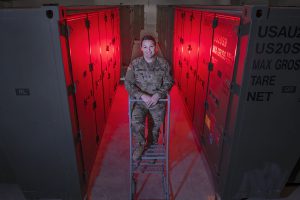 Sgt. 1st Class Jessica Rice has two jobs in the Idaho Army National Guard. During the week, she’s the accountable officer for the 116th Cavalry Brigade Combat Team’s Supply-Support Activity and during drill weekend, she’s a platoon sergeant for A Company, 145th Brigade Support Battalion.
Sgt. 1st Class Jessica Rice has two jobs in the Idaho Army National Guard. During the week, she’s the accountable officer for the 116th Cavalry Brigade Combat Team’s Supply-Support Activity and during drill weekend, she’s a platoon sergeant for A Company, 145th Brigade Support Battalion.
“I love it,” she said. “I’m responsible for training Soldiers. I get to teach them all the things I’ve learned in my 18 years and hopefully make them better than I am.”
As the accountable officer, she supervises seven Soldiers in the epicenter of logistics. The SSA provides a critical link between the brigade’s supply echelons and the national supply chain to ensure rapid fielding of repair parts, which drastically cuts down on the amount of time the brigade’s vehicles are down for maintenance issues.
Rice has supervised the SSA since it was established last year, a position typically held by a warrant officer. Only 11 National Guard states have an SSA.
Rice joined the Idaho Army National Guard after her first semester of college to help pay for her education. She ended up finding full-time employment in the organization before she could finish her degree. She’s been assigned to units in Boise and Burley as well as Lewiston and Post Falls multiple times.
“Throughout my time in the Guard, I’ve had six moves in 10 years,” she said. “Every time I’ve gone to a new unit, I’m instantly family. It doesn’t matter what I’m going through in my life, I have a dozen Soldiers who I could call at they’d be at my doorstep, and it wouldn’t matter why.”
At drill, Rice’s platoon of 22 Soldiers is responsible for distributing the brigade’s Class I (food, rations and water), V (Ammunition) and IX (repair parts) supplies.
As a leader, Rice said communication with her Soldiers is important.
“Make sure what you’re saying is what they are hearing,” she said.
1st Sgt. Lisa Carlin
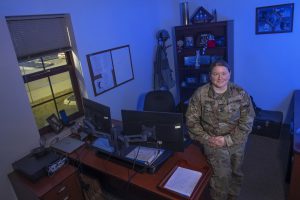 1st Sgt. Lisa Carlin remembers watching “Courage Under Fire” when she was 12 and knowing she wanted to join the military.
1st Sgt. Lisa Carlin remembers watching “Courage Under Fire” when she was 12 and knowing she wanted to join the military.
A few months after graduating high school, she enlisted into the Idaho Army National Guard in 2003 as a 15P aviation operations specialist. Unlike Meg Ryan’s character, she didn’t want to fly because she gets air sick. Aviation operation specialists support aviators from the ground and plan tactical missions.
Nearly two decades later, she is the first sergeant of 1-183rd Assault Helicopter Battalion’s Headquarters and Headquarters Company. As first sergeant, she is responsible for the health and welfare of more than 80 Soldiers.
“It’s all about taking care of Soldiers,” she said. “Regardless of what they have going on, they are the ones doing all the actual heavy lifting. If they aren’t getting taking care of, nothing else will get done.”
Carlin said she chose to join the Idaho Army National Guard over the U.S. Army because she wanted to remain close to home and pursue a college education.
“I already had friends and a support system here,” she said. “The idea of sticking around them seemed more appealing than uprooting every three years.”
Not only was Carlin able to remain close to her friends and family, but she has also made new friends over the years who feel like family.
“I like working with the same group of people throughout my career,” she said. “It builds a family mentality. You get to know them outside of work as well and become lifelong friends.”
The Idaho National Guard also gave Carlin the chance to serve with her actual family. Her sister is a security forces supervisor in the 124th Fighter Wing.
Carlin has been a member of the National Guard’s Active Guard/Reserve program since 2004. She’s served in multiple leadership positions in HHC before becoming its first sergeant. Currently, her readiness noncommissioned officer, Sgt. Kaitlyn Nicolosi, and training specialist, Spc. Jordyn Harris, are also female Soldiers entrusted with key company positions.
“Gender doesn’t play a role,” Carlin said. “It’s been my experience whoever does the job best gets the job.”
Chef Master Sgt. Kelly Bongiovi
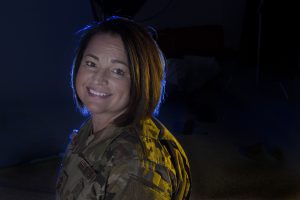 Chief Master Sgt. Kelly Bongiovi enlisted into the Idaho Air National Guard to provide a better life for her family. What she found was a career that has spanned more than three decades and led to her becoming the organization’s senior enlisted leader.
Chief Master Sgt. Kelly Bongiovi enlisted into the Idaho Air National Guard to provide a better life for her family. What she found was a career that has spanned more than three decades and led to her becoming the organization’s senior enlisted leader.
Bongiovi currently serves as the Idaho Air National Guard’s state command chief. By position, she is one of the Idaho National Guard’s most senior enlisted female members and she is the first female Airman to serve as the senior enlisted leader to the commander of the Idaho Air National Guard.
“I never planned on staying in the Air Guard this long,” she said. “I didn’t think they’d want met his long.”
Bongiovi enlisted in August 1991. She spent most of her career working nearly every logistic position in the 124th Fighter Wing before becoming the wing’s command chief in 2018. Over the years, the wing’s mission has changed from flying F-4s to flying A-10 Thunderbolt IIs and C-130s to only the A-10 mission. The logistics squadron’s name has also changed over that time, but Bongiovi’s work ethic has remained consistent.
“I was never in it to make a stripe,” she said. “I was always going to work my hardest and whatever came, came. I figured if I do good things, good things would happen. I just worked really hard and good things happened.”
Bongiovi decided to enlist shortly after tragically losing a child at birth. At the time, she was working in retail and the loss caused her to take a hard look at the life she would have been able to provide her child.
Several of her co-workers were members of the Idaho Air National Guard and told her about the many benefits they received as Guardsmen. Desert Storm was happening around the same time. Another co-worker’s husband deployed in support of the Gulf War but never made it home.
“I knew after I lost my kid, I needed to change my life,” she said. “I just had this passion of what I could do differently in the world to make a difference, not only for myself, but what I could do differently for my family. I also felt very passionate about what was going on in the world. I felt like I needed to join.”
Bongiovi said the biggest change she’s seen over the years is the seriousness of the National Guard’s mission and its increased operations tempo as the Guard became an operational reserve in the aftermath of 9/11. Bongiovi herself has deployed more than a half-dozen times in support of operations around the world.
Bongiovi has no question she was able to build a better life for her family since joining the Air Guard. She credits the support system she found through her fellow Guardsmen and the organization’s vast family resources as reasons why. In addition, she’s worked full time for the Idaho Air National Guard for the past 23 years and met her current husband through her military service.
Her husband, Hal, retired in 2020. He also served as the Idaho Air National Guard’s senior enlisted leader before advancing to the highest enlisted position in the Idaho National Guard as the state’s senior enlisted leader. Their oldest son is currently an A-10 Thunderbolt II crew chief in the 124th Fighter Wing and their youngest son is heavily involved in the organization’s family programs.
“You can pick yourself up when you have to and you can make yourself better,” she said, looking back on the path she’s taken since enlisting 31 years ago.
As the Idaho Air National Guard’s senior enlisted leader, she advises the commander of the Idaho Air National Guard, currently Brig. Gen. Tim Donnellan, on all enlisted matters. She said she doesn’t see the results of her work every single day like she could when she could physically watch A-10s take off and land on the flight line, but that the accomplishments feel much bigger when they do happen, however long they take.
She currently serves on the Air National Guard’s Enlisted Field Advisory Council. The committee works on proposed changes to policies and laws that impact Airmen across the force.
“When you see a policy go through that you’ve been working on for a year and it finally gets through the system and it’s going to make a change to thousands of Airmen, that’s a huge accomplishment,” she said. “It feels good knowing you’re going to help someone down the road.”
Bongiovi says she feels very privileged to serve in her current position but doesn’t dwell on being the first female Airmen to hold the position.
“I always try to help people,” she said. “I always tell Airmen to never miss an opportunity to learn no matter where they are in their careers. Look for something to work on and go work on it.”
In addition to looking for ways to improve, Bongiovi recommends having three people to confide in. She says have someone to tell the good, the bad and the ugly to, describing the good as the good things that happen; the bad things that happen; and someone who can help problem solve when necessary.
“The further you go up in the chain, the lonelier it gets,” she said. “You need people you can confide in when you start climbing the chain.”
Chief Warrant Officer 2 Kira Tank
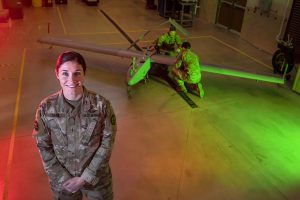 Chief Warrant Officer 2 Kira Tank is a dual-status federal technician, which means she has two jobs in the Idaho Army National Guard. During the week, she is the unmanned aerial systems supervisor for D Company, 116th Brigade Engineer Battalion. During drill weekend, she serves as the company’s operations officer and will become an instructor at the state’s Warrant Officer Candidate School next month.
Chief Warrant Officer 2 Kira Tank is a dual-status federal technician, which means she has two jobs in the Idaho Army National Guard. During the week, she is the unmanned aerial systems supervisor for D Company, 116th Brigade Engineer Battalion. During drill weekend, she serves as the company’s operations officer and will become an instructor at the state’s Warrant Officer Candidate School next month.
“I want to give back,” she said of her new position. “I’ve had a lot of excellent mentors and I think I can do that for other individuals and shape the future of the warrant officer cohort.”
Tank has served in the Idaho Army National Guard for the past 13 years. She began her career as an UAV operator before becoming a maintainer. She deployed with the 116th Cavalry Brigade Combat Team in 2010 in support of Operation New Dawn.
Upon returning from the deployment, she met then Chief Warrant Officer 3 George Tomlinson, who was assigned as the UAS platoon leader. She said she didn’t know much about warrant officers then, but Tomlinson mentored her and Jacob Stavenau and developed them professionally, which led to both Soldiers becoming warrant officers. Tomlinson now serves as the state command chief warrant officer.
As an enlisted member, Tank flew more than 350 UAV missions and reached the rank of staff sergeant before becoming a warrant officer.
“I love being able to bridge the gap between officers and the NCO corps,” she said. “Warrant officers are a very trusted profession. We’re subject matter experts. Officers rotate positions often and they lean heavily on us. They have to be able to trust us to give them the best advice.”
Tank said she joined the Idaho Army National Guard because she wasn’t sure what she wanted to do with her life, but she felt like the military was something she’d be good at. She said she’s made it a career because she really enjoys the comradery she’s found.
As the UAS supervisor, she oversees a team of eight Soldiers and coordinates missions for the company’s Shadow.
“We just have really great hard-working people who are held to a higher standard than their rank,” she said. “They have a lot of the same training and qualifications pilots do.”
She’ll take the lessons she’s learned from the past 13 years to her new position and use them to develop future leaders.
“Being a leader and a mentor is super important to me,” Tank said. “I’ll be able to play a key part in a pivotal point in someone’s career and be someone they can reach back to if they have questions.”
2nd Lt. Elizabeth Horan
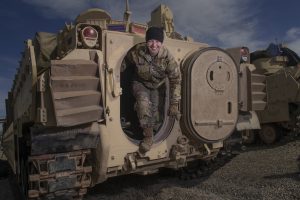 2nd Lt. Elizabeth Horan is a platoon leader for A Company, 116th Brigade Engineer Battalion. As a platoon leader, she leads three dozen 12B combat engineer Soldiers on the battlefield.
2nd Lt. Elizabeth Horan is a platoon leader for A Company, 116th Brigade Engineer Battalion. As a platoon leader, she leads three dozen 12B combat engineer Soldiers on the battlefield.
She joined the Idaho Army National Guard in 2017 as a 15D aircraft powertrain repairer and then earned her commission through BYU-Idaho’s ROTC program in 2020.
“I wanted to serve and to know that I contributed a little bit,” she said. “Plus, it’s fun.”
As a platoon leader, Horan said her job is making sure the platoon’s equipment is taken care of and that her Soldiers’ needs are met, in addition to making critical leadership decisions.
Combat engineers work to provide the maneuver commander with mobility, counter-mobility and survivability support, including detecting and clearing minefields and placing and detonating explosives. A Company uses Bradley Fighting Vehicles to provide engineer support to the 116th Cavalry Brigade Combat Team’s three combined arms battalions.
Horan said she enjoys getting to work with a Bradley crew and training with demolitions. As one of the Army’s junior officers, she relies on her platoon’s NCOs to help mentor her as she gains relevant experience in her career field.
“There’s a wealth of knowledge there,” she said. “A lot of those guys have been there for years and they are so willing to share what they know. It makes it fun to spend time with them on the Bradley and just do different things.”
As a platoon leader, she enjoys working with her Soldiers before she’ll take on additional administrative duties as she moves up in rank.
“Be willing to get dirty, get in and work hard next to your Soldiers,” she said. “Don’t try to excuse yourself from anything.”
1st Lt. Jessica Pauley
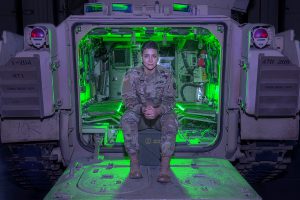 1st Lt. Jessica Pauley is thankful for the females who served before her.
1st Lt. Jessica Pauley is thankful for the females who served before her.
“They paved the way and without them, we wouldn’t be here,” she said.
As the first female infantry officer in the Idaho Army National Guard, Pauley helped paved the way for future female infantry Soldiers to serve in the 2-116th Combined Arms Battalion, but it’s a position she probably wouldn’t have sought out if she hadn’t been encouraged to do so by Sgt. 1st Class Melanie Galletti.
Galletti was the state’s first enlisted female Soldier to become 11B infantry qualified in April 2017. As part of the Army’s initiative to integrate females into combat arms positions, units were required to have a branch qualified female officer and a noncommissioned officer in place before new female recruits could be assigned to the unit.
Pauley knew that by becoming an infantry officer, along with Gelletti, she would pave the way for females to serve in the unit. Since then, several females have served in the state’s only infantry company, but Pauley is currently the only female assigned to the unit.
She’s a platoon leader for C Company, 2-116th Combined Arms Battalion. She oversees four Bradley Fighting Vehicle crews, including her own, and three squads of dismounted infantry Soldiers.
“It’s exactly the stuff people generally join the Army to do,” she said. “We shoot, we do squad and platoon exercises and there’s lots of hands-on training, including demolitions.”
Pauley said the hours are long, but the job is fun. She trains yearlong to be able to meet the physical demands of the job.
“It’s part of my job to be as physically fit as I can be,” she said. “If it comes down to it, Soldiers expect that from me and I expect that from them. Just like I’d expect any of my Soldiers to be able to pull a fully kitted Soldier out of a Bradley Fighting Vehicle while under fire. It’s dangerous if they can’t do it. It’s dangerous if I can’t do it as well.”
Pauley enlisted into the Idaho Army National Guard on her 23rd birthday in 2014. She served as a public affairs specialist before enrolling into the Boise State University ROTC program for her final two years of college. She said getting school paid for and getting paid to go to school seemed like a really good idea.
“It’s a good opportunity for everyone,” Pauley said. “It’s a relatively small commitment and you get the benefits of giving back to your country.”
Pauley has spent most of her career as a part-time Soldier and is looking forward to deploying with the 2-116th Combined Arms Battalion later this year so that she can spend additional time with her platoon.
“I’m excited for the opportunity to get some quality time with my platoon and train,” she said. “When we only see our Soldiers one weekend a month and a few weeks in the summer, there’s only a certain level of proficiency you can hit with that amount of time. We will have the chance to train every day and set some things in stone for Charlie Company that will last longer than our time in the unit.”
Pauley earned her commission in 2018 and attended the US Army’s Infantry Basic Officer Leaders Course in June 2019.
“The entire experience is a learning experience from the moment you swear in,” she said. “You’re faced with challenging situations, and you have to learn as much as you can from each one.”
As she’s grown throughout her time in the Army National Guard, she’s also thankful for those who have mentored her along the way.
“The commanders and first sergeants I’ve had the honor and privilege of serving with have taught me so much and they care so much about Soldiers,” she said. “It’s really inspirational.”
Capt. Haily Barley
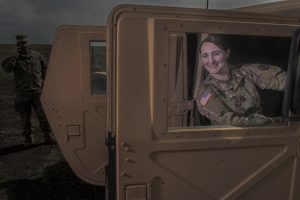 Capt. Haily Barley serves as the commander of Headquarters and Headquarters Company, 2-116th Combined Arms Battalion. She initially commissioned as a signal officer after graduating from the University of Idaho’s ROTC program but rebranched as an armor officer to be closer to the fight on the ground.
Capt. Haily Barley serves as the commander of Headquarters and Headquarters Company, 2-116th Combined Arms Battalion. She initially commissioned as a signal officer after graduating from the University of Idaho’s ROTC program but rebranched as an armor officer to be closer to the fight on the ground.
“I loved the signal community,” she said. “But at the end of the day, I’m just more comfortable and confident in this role, especially with my civilian career. I love it. You’re fighting the fight and have to make decisions more quickly.”
Barley served as a platoon leader and executive officer in the battalion before assuming command of its headquarters unit. As the commander, she is responsible for more than 180 Soldiers and ensures the battalion’s scouts, mortars, snipers, medics and staff are ready to execute their missions when called upon.
“The biggest part is just taking care of your Soldiers, wholeheartedly and leading from the front,” Barley said. “If they are not taken care of, then you don’t have a fight.”
The battalion is scheduled to deploy later this summer.
“I’m excited, but it’s bittersweet,” she said. “Now that I have kids, it’s a little rough, but it’s pretty much the reason you join.”
In addition to serving in the Idaho Army National Guard, Barley is a patrol deputy for the Canyon County Sheriff’s Office.
“Don’t be afraid to make decisions,” Barley said. “Someone might think you’re being bossy or bitchy, but you’re just trying to get your job done. Don’t be afraid to take the reins and learn or fail.”
Maj. Kristin Daigle
 Maj. Kristin Daigle enlisted into the Idaho Air National Guard in 2004 to help pay for college.
Maj. Kristin Daigle enlisted into the Idaho Air National Guard in 2004 to help pay for college.
She attended college at Boise State University without having to take out any student loans and found full time employment within the 124th Fighter Wing shortly after graduation. With her degree, she was also able to commission as an intelligence officer.
“I always wanted to be an officer,” she said. “The timing seemed right.”
Daigle was hired to be an instructor for the wing’s Intelligence Formal Training Unit after spending seven years as an enlisted intelligence analyst. She also worked as the wing’s sexual assault response coordinator and as the executive officer for the Idaho Air National Guard.
Today, she’s the commander of the 124th Fighter Wing’s Maintenance Operations Flight, a position she sought for increased leadership responsibilities.
“Best decision I ever made,” she said. “I love being in maintenance!”
The flight is responsible for the long-range management of the wing’s A-10 Thunderbolt II aircraft and manages aircraft maintenance to meet operational requirements for the 190th Fighter Squadron.
“There are different challenges presented every day,” she said. “There’s always something breaking and you have to figure out how to fix it and still meet the wing’s flying schedule.”
The flight consists of five shops and more than 20 Airmen. Daigle has been in command of the flight since 2019.
“It’s given me an appreciation for everyone’s different perspectives that they bring to the job and I try to balance the mission requirements with making sure the people are taking care of,” she said.
Lt. Col. Christina Taylor
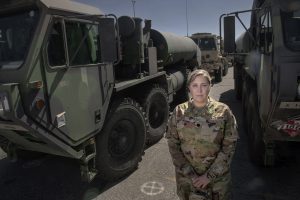 Lt. Col. Christina Taylor joined the University of Idaho Army ROTC program to help pay for college. She chose to commission into the Idaho Army National Guard after graduating so she could have a hand in deciding her future.
Lt. Col. Christina Taylor joined the University of Idaho Army ROTC program to help pay for college. She chose to commission into the Idaho Army National Guard after graduating so she could have a hand in deciding her future.
“I didn’t want the Army to choose for me,” she said. “I wanted to create my own path.”
By serving in the National Guard’s Simultaneous Membership Program, she was able to drill with an Idaho Army National Guard unit while still in college and identify a position for her to serve in after commissioning. Had she chosen to serve in the active Army, the Army would have selected her assignment and duty location.
Taylor drilled with C Company, 145th Brigade Support Battalion, 116th Cavalry Brigade Combat Team and remained with the unit after she commissioned in 2002. It began a path that has led to multiple command positions for Taylor since 2015.
In 2015, Taylor led the Mission Training Complex – Gowen Field. After a short break, she commanded C Company, 145th BSB for most of 2017. She then took command of the Idaho National Guard’s 101st Civil Support Team in February 2018 before transitioning out of that position to command the 145th Brigade Support Battalion last year.
As the 145th BSB commander, Taylor is the 116th Cavalry Brigade Combat Team’s senior logistician and is responsible for ensuring the unit’s maneuver commanders can maintain their operational reach for prolonged periods of time by maintaining logistical and sustainment support in the operational environment. The battalion consists of more than 400 Soldiers that comprise a distribution company, a field maintenance company and a medical support company in addition to forward support companies located throughout the state.
Taylor is also the brigade’s highest-ranking female Soldier, a fact she doesn’t pay much attention to.
“Never in my career has it ever been about me being a woman,” she said. “It’s always about being capable to assist the organization. The Guard’s provided a really great career path for me to be able to grow and learn as a leader. That’s why I chose to make it a career.”
Taylor earned her degree in elementary education and worked as a teacher prior to deploying with the 116th CBCT in 2005 in support of Operation Iraqi Freedom III. She started working fulltime for the Idaho National Guard shortly after returning home from deployment when she was hired as the medical operations officer for the 101st Civil Support Team.
“I like how we can directly give back,” she said. “You can show how one person can actually have an impact and give back to our fellow citizens, state and nation.”
Taylor describes leadership as an upside-down triangle, with leaders representing the bottom point, holding up and supporting Soldiers.
“We work to meet their needs,” she said. “With that mindset, we accomplish a lot more.”
Col. Elizabeth Sumner
 Col. Elizabeth Sumner is the highest-ranking female in the Idaho National Guard. She leads more than 340 Airmen as the 124th Mission Support Group commander.
Col. Elizabeth Sumner is the highest-ranking female in the Idaho National Guard. She leads more than 340 Airmen as the 124th Mission Support Group commander.
The 124th Mission Support Group consists of four squadrons and one flight and provides a wide range of support for the 124th Fighter Wing. The group includes facilities, communications, security forces, logistics, civil engineering, contracting and force support.
“People are my mission,” she said. “I focus on getting them the resources they need to be successful because they are the ones who accomplish the Air Force’s mission.”
Sumner began her career in the United States Air Force before transferring to the Idaho Air National Guard in 2008 to find a good balance between having a military career, a civilian career and a spouse who also served in the Air Force.
“I thought it was the perfect marriage of things I liked to do,” she said. “I drilled on the weekends and I worked for an engineer company in Boise during the week.”
Sumner served in the Alaska National Guard and the Florida National Guard as her husband received new assignments before transferring back to the Idaho Air National Guard again in 2014 when he retired.
“I always wanted to serve,” she said. “I like being part of something bigger than myself and I like the discipline that comes with serving in the military.”
Sumner started her military career as an intelligence officer and later became an instructor at the wing’s Intelligence Formal Training Unit. She realized that the same qualities that would make her a good instructor to her students would also make her a good leader to her Airmen: be humble, credible and approachable.
“I think what we do in the Guard is such an incredible balance to the active duty,” Sumner said. “It comes from vast different experiences everyone brings. As a leader, it’s important to realize that differences can be a huge strength to an organization and that we should invite those differences of opinion, perspectives and experiences so we can get to the best solutions.”
Guardsmen help with understaffing, serve locally
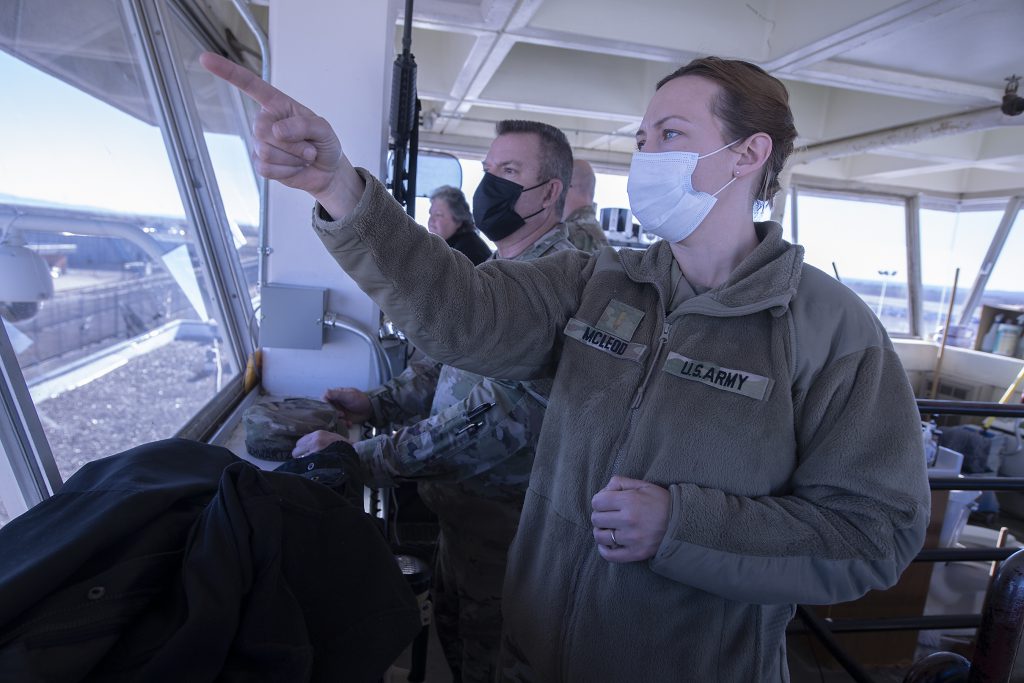
Maj. Robert Taylor/Idaho Military Division Public Affairs
Spc. Kyle Shuman grew up an Army brat and wanted to enlist into the Army himself. Five years ago, he enlisted into the Idaho Army National Guard as a 68W combat medic.
“I wanted to follow in my dad’s footsteps,” he said. “He used to say good things about the military. I thought that being in the National Guard would be a good way to serve in my community and still be in the military and have a civilian career.”
Shuman is one of approximately 75 Idaho National Guardsmen currently assisting the Idaho Department of Correction overcome staffing shortages due to the COVID-19 pandemic. Gov. Brad Little activated the Idaho National Guard for the fourth time Jan. 31, which also included support at multiple Primary Health Medical Group locations until Feb. 25.
Citizen-Soldiers and Airmen are performing non-security duties while the department is severely understaffed. He previously volunteered with the task force last year and deployed to Washington, D.C. in June 2020 to assist local civil authorities as part of an effort that included more than 5,000 National Guardsmen from 11 states and Washington D.C.
“I didn’t know what the mission would be,” he said. “I just volunteered to get new experiences and to get to do things I don’t get to do everyday and to meet people from other units.”
At the prison, Shuman said he assists with monitoring cameras in a control center and opens and closes doors as requested by correctional officers. Shuman said Guardsmen performing similar tasks throughout IDOC facilities helps free up correctional officers to perform security duties. The additional personnel allow residents to move around the facility as normal. Prior to the Idaho National Guard assistance, residents spent an increased amount of time in their cells throughout the day due to a lack of correctional officers.
“It makes me feel good to go out there and help the correctional officers with whatever they need help with,” said Sgt. 1st Class Vincent Mele, the non-commissioned officer in charge of the Idaho Guardsmen working at the state’s minimal security facility.
Mele is working at the facility’s front desk, where he helps sign visitors and staff in and out of the prison and answers the prison’s telephone.
“This mission provides a really good perspective on the world that maybe you didn’t have before hand,” he said. “We all get an idea of what the prison system might be like, and it’s definitely a little different in Idaho than I pictured.”
Guardsmen anticipate assisting IDOC until mid-March. Shuman, Mele and other Guardsmen will then return to their civilian jobs in their respective communities.
“We thank you for everything you’re doing for our staff and residents,” said Warden Timothy Richardson. “Before the Idaho National Guard arrived, at one point we were down to 48% staffing. We realize this is a unique and uncertain environment, but you’ve provided a solid cadre of troops and we couldn’t ask for a better group at such a critical time.”
Idaho Army National Guard deploys to Southwest Asia
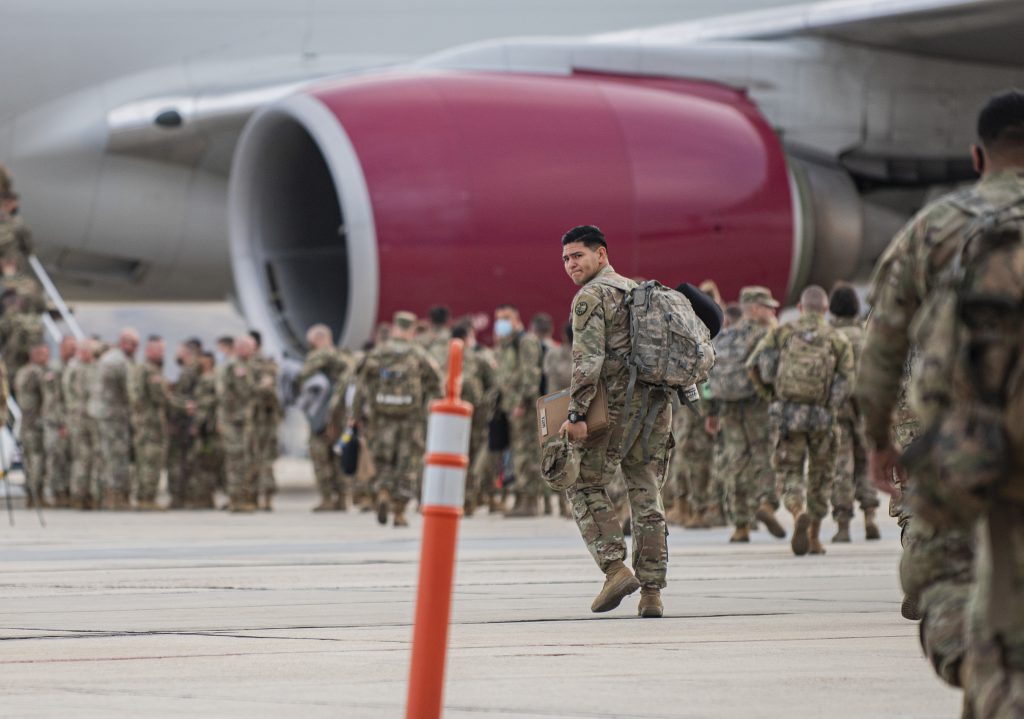
More than 250 Soldiers from the Idaho National Guard’s largest unit, the 116th Cavalry Brigade Combat Team, left for a 12-month deployment on Nov. 5 to Southwest Asia in support of Operation Spartan Shield. The brigade has trained for more than a year in anticipation of this mobilization.
OSS is a joint mission under the United States Central Command and is part of Operation Enduring Freedom. Idaho Soldiers will comprise nearly 20 percent of the 116th CBCT task force during this rotation. Soldiers from 116th CBCT units in Montana, Nevada and Oregon, as well as the Florida Army National Guard, will also fall under the task force.
“The Soldiers of the 116th are trained and ready to go,” said Lt. Col. Eric Orcutt, 116th CBCT commander. “I could not be more proud of these men and women and the efforts they’ve put forth in training and preparing for this mission. They are eager and they are focused and as always, they will achieve the highest level of success.”
OSS is an ongoing operation and supported primarily by Army National Guard units from across the country. This deployment is anticipated to last approximately 12 months and is the first rotation the brigade is scheduled to support, with the second rotation occurring in the summer of 2022. The Soldiers mobilizing today will receive 45 days of additional training stateside before deploying overseas.
The 116th Cavalry Brigade Combat Team previously deployed in support of the Global War on Terror in 2004 and 2010 to Iraq. Additionally, more than 400 Idaho Air National Guardsmen deployed to Southwest Asia in the summer of 2020.
 Official Government Website
Official Government Website